This sourdough baguette is everything you want in the French classic–a crunchy crust, an open, airy crumb, and lots and lots of flavor. And it’s easier to make than you think! Eat it plain, slathered in butter, or serve it with your favorite soup. For best results, this recipe requires sourdough starter, kitchen scale, a baguette pan and 3 days. See all our sourdough recipes here!

How to make Sourdough Baguettes! By now, many of you have perfected your Easy Sourdough Bread, and I thought I’d share a recipe for Sourdough Baguettes that will introduce a couple of new terms and techniques to add to your growing repertoire. This recipe was created by my friend, Kris Osborne, over at Baked- the blog.
She’ll introduce you to the terms “levain” and “autolyse”, two things I intentionally omitted from the Sourdough Bread recipe to keep it as simple as possible. But I know you are ready now! You’ll recognize the stretch and fold technique and will have, by now, be able to do this with your eyes closed. I’m so excited for you to try this. Keep in mind this recipe takes 3 days.
How to make Sourdough Baguettes| step-by-step Video
Sourdough Baguette ingredients
- Active, bubbly starter (make sure it doubles within 6 hours of feeding)
- Bread flour -try for organic, locally milled, if possible. 🙂
- Salt
- A scale
- Baguette Pan
STEP ONE: The night before you plan to make the baguette dough, make the levain: In a medium bowl, mix together the starter, water, and bread flour until well-combined. Cover with a plate and rest overnight (8-12 hours) until very bubbly and active.
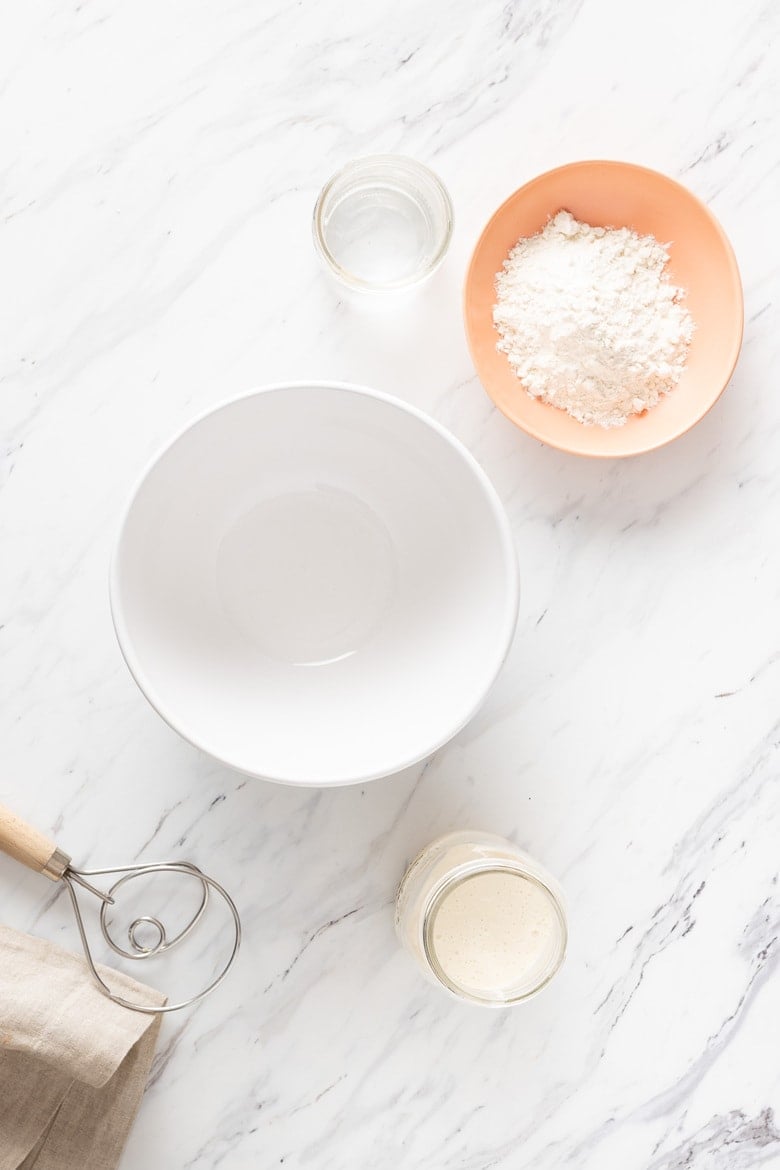
The levain should have many small bubbles across the top and throughout.
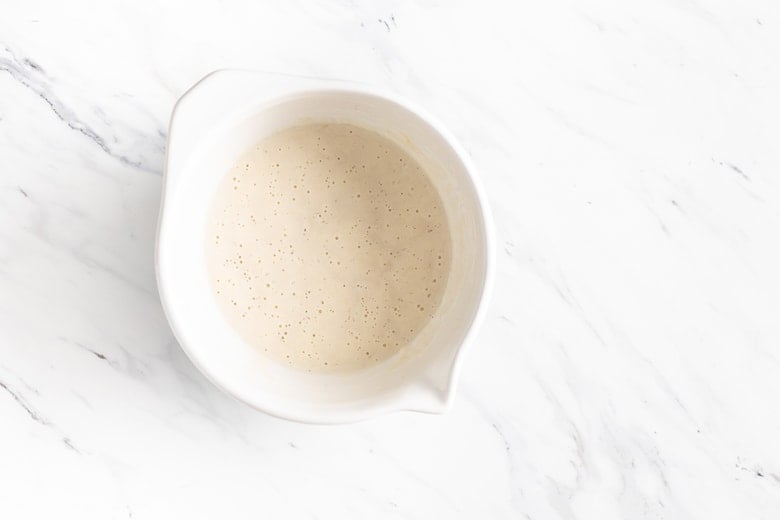
STEP TWO: Day two, morning. Transfer all of the levain to a large bowl. Add the water and bread flour, and mix until all of the flour is incorporated and a shaggy dough is formed. Cover with a lid or damp towel and set aside 45 minutes to rest. This is called the autolyse.
STEP THREE After the 45-minute rest period, add the salt to the dough and squeeze and pinch the salt into the dough until evenly distributed. Perform a set of stretch and folds (see notes), then cover and set aside for 30 minutes to rest.
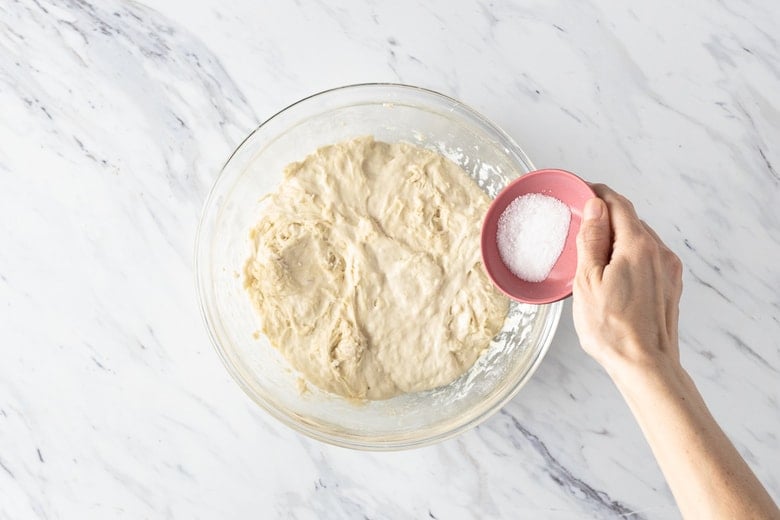
STEP FOUR: Continue to perform a set of “stretch and folds” every 30 minutes for 3 hours, covering and resting in between each round.
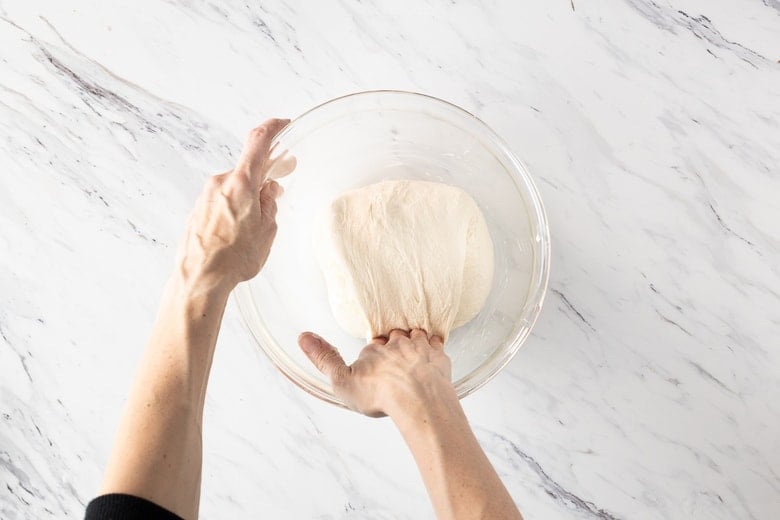
How to do the Stretch and folds
To perform a series of stretch and folds, imagine the dough in 4 quadrants. Grab the dough in the 12 o’clock position and pull it up and over toward yourself (toward the 6 o’clock position). Watch the video above.
Then, rotate the bowl a quarter turn to the right and grab the dough in the 12 o’clock position again (formerly 9 o’clock), bringing it up and down toward 6 o’clock once more. Repeat this step 2 more times until each quadrant of the dough has made it to the 12 o’clock position and has been stretched and folded onto itself.
The dough will look like a little parcel.
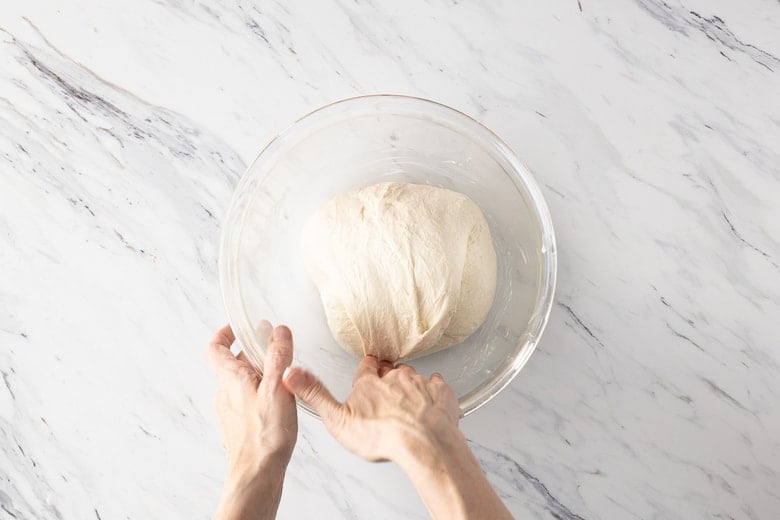
STEP FIVE Shape! Gently tip the dough onto a lightly floured surface and cut it into 3 equal portions. Using a circular cupping motion with the palm of your hand, gently roll each ball of dough on the countertop to create a taut ball.
Gently dust with flour and cover with a towel. Bench rest 30 minutes.
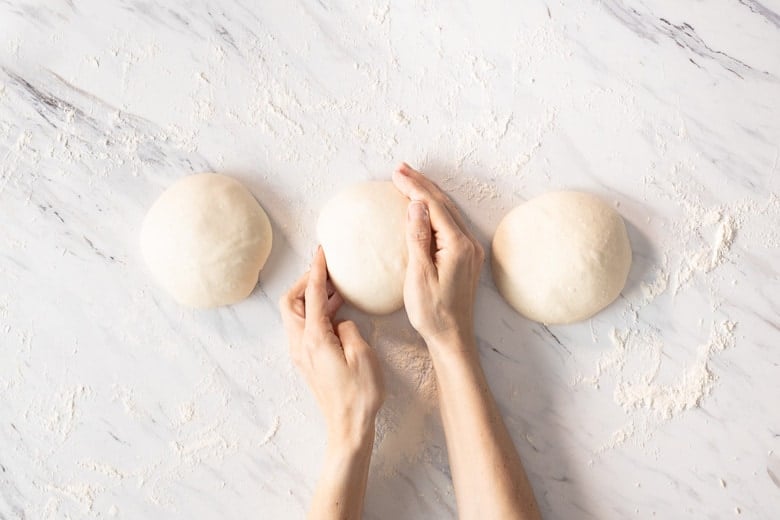
Sprinkle your countertop with flour and gently pat the first ball of dough into a rectangle, approximately 9-inches long. Fold the top third of the dough down (like folding a business letter) and press it into the dough, using the heel of your hand, to stick the edges together.
Rotate the dough 180 degrees and repeat so that both the bottom and top thirds have been folded in. Fold the dough in half once more to create a slim silhouette, and, again, use the heel of your hand to connect the edges. Roll the dough so it’s seam-side down and press and roll the dough out so that a baguette shape forms, pinching the edges to taper them, if necessary.
Place seam side down on a greased baguette pan or on floured parchment-lined sheet pan. Please refer to video above!
STEP SIX. Cover with plastic wrap and refrigerate overnight.
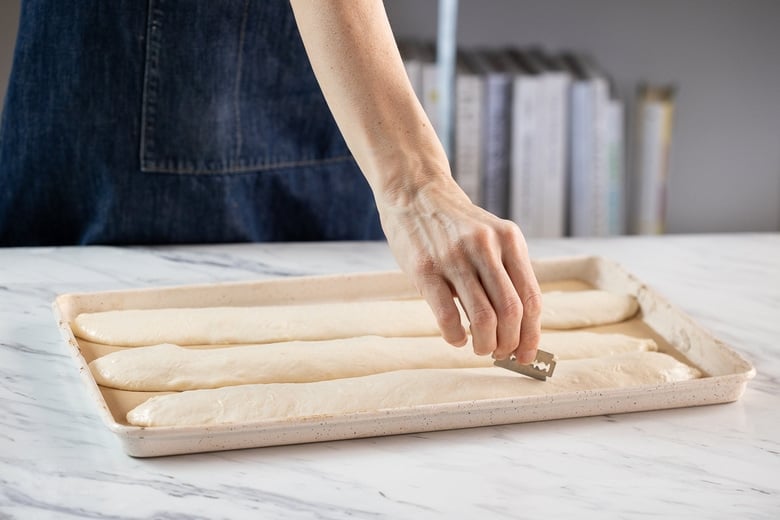
STEP SEVEN: Day 3: The next morning, preheat the oven to 500°F (260°C) with the oven racks positioned in the middle and one level below.
Bake the baguettes directly on baking sheet or the baguette pan. Keep in mind, the baguette pan will leave slight perforations on the bottom of the bread.
Using a lame (or sharp knife or razor blade), make 3-5 diagonal slashes into each piece of dough.
BAKE! Place a handful of ice cubes onto the second baking sheet. Immediately place the baguette dough into the oven on the middle rack and place the baking sheet with ice on the rack below. Close the oven door and turn the temperature down to 450°F. Bake for 30 – 35 minutes, or until the bread is a deep golden brown.
Remove from the oven and cool on a wire rack.

How to store Baguettes
Bread is best eaten on the day that it’s made, but if stored in paper will keep an additional day.
You can freeze baguettes sliced or whole. If slicing, freeze individual slices on a baking sheet, then place into a freezer bag. If freezing whole, wrap tightly with aluminum foil or plastic freezer wrap, then place in a freezer bag. Bread will keep this way for a few months.

Enjoy the process of learning how to make Sourdough Baguettes and let us know how it goes! Take a peek at all our sourdough recipes!
Happy Baking!
More Favorite sourdough recipes
- Jalapeño Cheddar Cheese Sourdough Bread
- Simple Sourdough Starter
- Sourdough Pizza Crust
- No-Knead Sourdough Bread
- Rosemary Olive Sourdough Bread
- Sourdough Crackers
- Vegan Banana Bread
- Overnight Sourdough Waffles
- Sourdough Pancakes
- Sourdough Scones
- Sourdough Biscuits
- Sourdough Buns
- Sourdough croutons

Sourdough Baguette Recipe
- Prep Time: 36 hours
- Cook Time: 35 mins
- Total Time: 36 hours 35 minutes
- Yield: 3 14-inch baguettes
- Category: bread, sourdough, baked
- Method: baked
- Cuisine: French
- Diet: Vegan
Description
This sourdough baguette is everything you want in the French classic–a crunchy crust, an open, airy crumb, and lots and lots of flavor. And it’s easier to make than you think! Eat it plain, slathered in butter, or serve it with your favorite soup. For best results, this recipe requires a kitchen scale, a baguette pan and 3 days time!
Ingredients
For the levain:
- 65 grams active bubbly starter
- 65 grams tepid water
- 65 grams bread flour
For the dough:
- 420 grams tepid water
- 600 grams bread flour
- 12 grams salt
Instructions
Day 1: (Evening) Make the Levain
Make the levain: In a medium bowl, mix together the starter, water, and bread flour until well-combined. Cover with a plate and rest overnight (8-12 hours) until very bubbly and active. The levain should have many small bubbles across the top and throughout.
Day 2: Mix the dough, first rise, and shape.
- In the morning, transfer all of the levain to a large bowl. Add the water and bread flour, and mix until all of the flour is incorporated and a shaggy dough is formed. Cover with a lid or damp towel and set aside 45 minutes to rest. This is called the autolyse.
- After the 45 minute rest period, add the salt to the dough and squeeze and pinch the salt into the dough until evenly distributed. Perform a set of stretch and folds (see video), then cover and set aside for 30 minutes to rest.
- Continue to perform a set of stretch and folds every 30 minutes for 3 hours, covering and resting in between each round.
- Gently tip the dough onto a lightly floured surface and cut it into 3 equal portions. Using a circular cupping motion with the palm of your hand, gently roll each ball of dough on the countertop to a create a taut ball. Gently dust with flour and cover with a towel. Bench rest 30 minutes.
- Shape: Sprinkle your countertop with flour and gently pat the first ball of dough into a rectangle, approximately 9-inches long. Fold the top third of the dough down (like folding a business letter) and press it into the dough, using the heel of your hand, to stick the edges together. Rotate the dough 180 degrees and repeat so that both the bottom and top thirds have been folded in. Fold the dough in half once more to create a slim silhouette, and, again, use the heel of your hand to connect the edges. Roll the dough so it’s seam-side down and press and roll the dough out so that a baguette shape forms, pinching the edges to taper them, if necessary.
- Place seam side down on a greased baguette pan or heavily dusted, parchment-lined sheet pan.
- Cover with plastic wrap and refrigerate overnight.
Day 3: Morning. Preheat, score and bake!
The next morning, preheat the oven to 500°F (260°C) with the oven racks positioned in the middle and one level below. Have a baking sheet ready to add ice cubes to. (See notes.)
Score: When the oven is hot, remove the baguette dough from the fridge. Using a lame (or sharp knife or razor blade), make 3-5 diagonal slashes into each piece of dough (¼-½ inch deep).
Bake: Place a handful of ice cubes onto the second baking sheet. Immediately place the baguette dough into the oven on the middle rack and place the baking sheet with ice on the rack below. Close the oven door and turn the temperature down to 450°F. Bake for 30 – 35 minutes, or until the bread is a deep golden brown. Remove from the oven and cool on a wire rack.
Bread is best eaten on the day that it’s made, but if stored in paper will keep an additional day. You can freeze baguettes sliced or whole. If slicing, freeze individual slices on a baking sheet, then place into a freezer bag. If freezing whole, wrap tightly with plastic freezer wrap, then place in a freezer bag. Bread will keep this way for a few months.
Notes
Stretch and folds: To perform a series of stretch and folds, imagine the dough in 4 quadrants. Grab the dough in the 12 o’clock position and pull it up and over toward yourself (toward the 6 o’clock position). Then, rotate the bowl a quarter turn to the right and grab the dough in the 12 o’clock position again (formerly 9 o’clock), bringing it up and down toward 6 o’clock once more. Repeat this step 2 more times until each quadrant of the dough has made it to the 12 o’clock position and has been stretched and folded onto itself. The dough will look like a little parcel.
Baking: When transferring the cold baguette dough to a parchment-lined pan, it will be snake-ish and hard to work with. Move quickly and efficiently so you don’t disrupt the shape of the baguette too much. Alternatively, you can bake the baguettes directly on the baguette pan until you get more comfortable working with the dough. Keep in mind, the baguette pan will leave slight perforations on the bottom of the bread.
Steam: Create steam by placing ice cubes on a sheet pan on the lowest rack, under the baguettes.
Nutrition
- Serving Size: ¼ of a baguette
- Calories: 196
- Sugar: 0.2 g
- Sodium: 388.7 mg
- Fat: 0.9 g
- Saturated Fat: 0.1 g
- Carbohydrates: 39.3 g
- Fiber: 1.3 g
- Protein: 6.5 g
- Cholesterol: 0 mg






I live in a cooler climate, it’s about 65 degrees in my kitchen. Can I proof this overnight on the counter top? (My fridge is very cold so am worried about putting it in the fridge overnight…)
Give it a try?
I made this recipe over the weekend and it turned out fantastic 🙂 I did end up refrigerating the dough and it worked out just fine. So excited to make more baguettes! Thank you!!
Great to hear!
I hope to make the levain at 3pm today before going to a party, and then I will make the baguette dough tomorrow around 9am. is that ok?
that sounds fine!
Thank you for an amazing recipe, best Sourdough recipe going around (have tried many) I have made these baguettes many times and adjusted flours eg 400 white with 200 rye/200 rye multi and it hasn’t failed me yet. Left on counter for longer than 3hrs and still turned out perfect it’s a totally flawless receipe.
Thanks so much Emma! Glad this worked for you!
Great recipe, thank you very much for sharing.
I do have 1 question: do you know why the baguettes would split/crack half way through the baking process? I have made them so many times and every now and then they crack/split open on the top.
I’m not sure? You could try playing with the proofing times, try shortening a bit?
My husbands favourite bread is sourdough. My toddler and I started a sourdough starter last March (our first covid project) and it has been going strong ever since.
I’m making a charcuterie board for Father’s day and thought some baguette slices would be a marvelous addition. I baked them off this morning and sliced for the freezer (I have to take my time when I can…busy house!)
Of course I had to toast a slice and slather with butter.
Wonderful. He is going to love it!
Thanks for a great recipe with easy to follow steps!
Thanks and so happy this worked for you Sarah!
I think this recipe is well done and very informative but I did not get good results. I believe in my case that it’s the water to flour ratio. I’m in a very humid climate and my dough was very sticky. It never set up right. I followed the directions properly. So I’ll have to try it again.
Thank you so much for the recipe! I love that it doesn’t take extra yeast and it’s strictly sourdough.
I’m sorry Rhonda, I will have to make these again.
of all the baguette recipes I’ve tried (and I’ve tried a few), this one is the best. I like the fact that it is completely sourdough based. The recipe is straight forward and simple. I still have yet to achieve the open airy-ness of a classic baguette. My baguettes have great flavor and a slight sourdough tang, but are too “bready” or thick like a loaf of bread. In the future I’ll increase proof time and see if that helps. I have to tell you that I aim to make a baguette similar to the ones I’ve eaten in California’s Bay Area, for example, Acme Bread. Thank you for the recipe.
Thanks so much Patrick- glad this is working for you!
I tried this recipe based on the convenience factor of pulling it from the fridge and straight to the oven. I disregarded basic bread science and payed the price, cold dough in an oven will create overly dense, overly chewy, Underproofed “bread”. Skipping the final proof is a bad idea, otherwise great sour flavor and aroma from that overnight in the fridge.
Sorry about that Joseph, half of the proofing here is done before it goes into the fridge for the final rise. Also fridge temps vary greatly- so if yours is very cold, it may have halted the rise. Also It is pretty essentional that starter is healthy and active (doubling within 6 hours of feeding). So many variables here.
I do not see how much starter you put into the dough in your recipe. Please help!! I love all your recipes and eager to make your sourdough baguette bread. I have a very good starter that I keep active and also use my discard for many recipes.
HI . I think I have it figured out now. I just make the levain from my active starter. Is is okay to use my French whole wheat flour instead of the bread flour in your recipe. Thank you for all your help. Sandy
My second attempt at making these baguettes was a success! This time, I made sure the levain is very active. Instead of ice cubes, I added boiling water to the pan then removed it after 10 minutes.
Yay Batoul!!! Gald it worked!
Hi Sylvia! I am going to try your sourdough baquettes tomorrow. I would also like to try adding diastic malt. Do you know how much I should add for this recipe and when should I add? I appreciate any of your expert advice!
I actually have never tried adding – though I’ve heard some people get good results. If you add will you let us know how it turned out?
Worked first time for me. Very easy to follow and beautifully simple. May reduce oven heat slightly.
Thank you for this.
So I’ve tried these twice now, without much luck Dough doesn’t seem anywhere near as firm as in your photos, very wet as well. Starter was great plenty of air and floated, plenty of bubbles on Levain next morning but the resulting dough after stretch and fold was almost flat. Can you offer any suggestions.
Hey Tom, did you weigh the ingredients? Or measure?
I recently bought the baguette pan for this recipe and made it. The baguettes came out of the oven looking gorgeous and I rushed to send pictures of them to my family, but when I cut them open, they had few air bubbles and the dough was a little dense. I think this is because my levain did not peak and it only had tiny bubbles after resting overnight, even though I took it out of an active sourdough starter. Still, it tasted good and my neighbor enjoyed the loaf I gave her. I will try making it again with an active sourdough starter.
Thanks Batoul! Yes keep me posted if you make again.
and I even bought a baguette pan for this, glad I did!
wow! I did it! this is why I made my sourdough starter. Thanks so much for such detailed and informative instructions and videos!! They came out great! I want to eat all three but I know that is not a good idea!
Glad they worked Linda!
Yes your no knead is my go to recipe as well. I have a question though- I dont have a baguette pan. Can I use a baking sheet rather than a baguette pan? or will that mess up the shape? Love your site and your recipes!! Thank you!
The baguette pan will keep them looking cleaner, straiter and more uniform, but a sheet pan is OK. 🙂
Thank you for this. – I have wanted to try baguettes for a while now but all the recipes seem do complicated. I have made the baguettes twice now and they are amazing – they taste great after being frozen too – thank you for the recipe – it’s really accessible-the only thing is I feel my oven is too hot at the temperature stated ( after 30 mins ) and they tend to be too golden – will try it on a reduced heat as I have a fan oven . Do you have a croissant recipe – would love to give them a go too – thank you x
Glad this is working for you! No croissant recipe yet- but something to think about for sure!
Best banquette recipe I’ve tried. Very little hands on and the results are bakery worthy. Your no knead sourdough bread is my go to recipe…thank you for sharing.
Baked baguettes this week and had to throw two in the freezer right away so we wouldn’t gorge ourselves! So, so good! Great crisp, chewy crust, tender crumb… The recipe is clear and easy to follow and even though they are a three day process, there was very little hands on time – and by the time the third day rolled around – the anticipation was like a child waiting for Christmas Day to arrive – excruciating! Thanks for another great sourdough recipe!
Great to hear they worked for you!
Hello. Thank you for the recipe. I was wondering if The dough can be left in the refrigerator for longer than overnight in the event it can’t be baked the next morning
I haven’t experimented with this yet- my guess is probably but not 100% sure.
Hi Donna, I put my baguettes in the fridge around noon on day 2 and and baked them in the morning on day 3 – so they basically stayed longer than overnight. It worked well. However, I could see on the dough that it was the time for them to get baked, I would say don’t leave it longer than 18 hours int he fridge.
Thanks Simona! This is helpful!
So.. Yesterday was my 2nd time baking these..I left them in the fridge longer than overnight (they went in the fridge on day 2 at 3PM and baked them at 12:30PM on day 3 – they overfermented in the fridge!). Oops, I forgot 🙂 But at least I share the experienced of this-time “failed” technique ;-). So really, keep an eye on the watch while they’re in the fridge.
Thanks Simona! Yes, that can happen!
Worked fantastically well! Simona
It seems to load now
Hi Sylvia, the video above will not load. Thanks
Refresh the page, and give it 10 seconds. 🙂
Hi Sylvia
I love visiting your website. And I’m all the way from Johannesburg in South Africa.
I’d love to try your sour dough recipe, but am new to this. You mention a video, but I cannot find a link to it.
Enjoy your weekend.
Kind regards
Clive
Just give it a few seconds, do you see the title? If you still don’t see, see that your ad blocker is turned off.